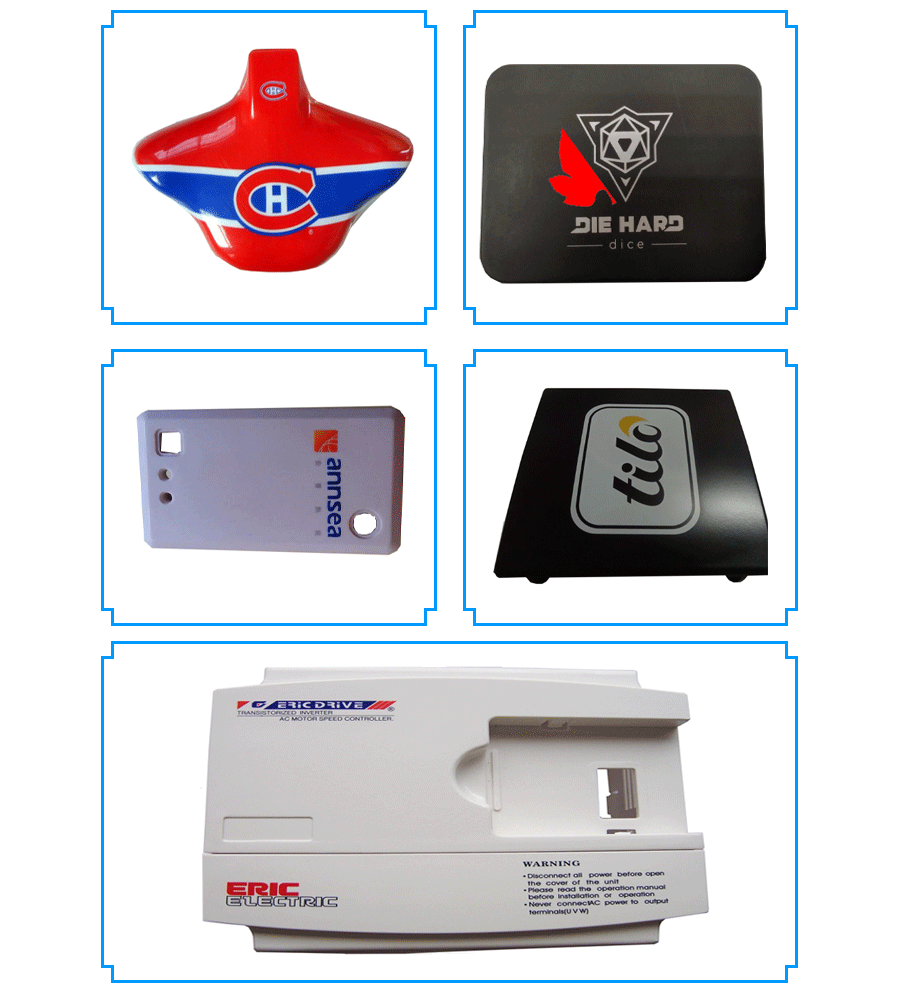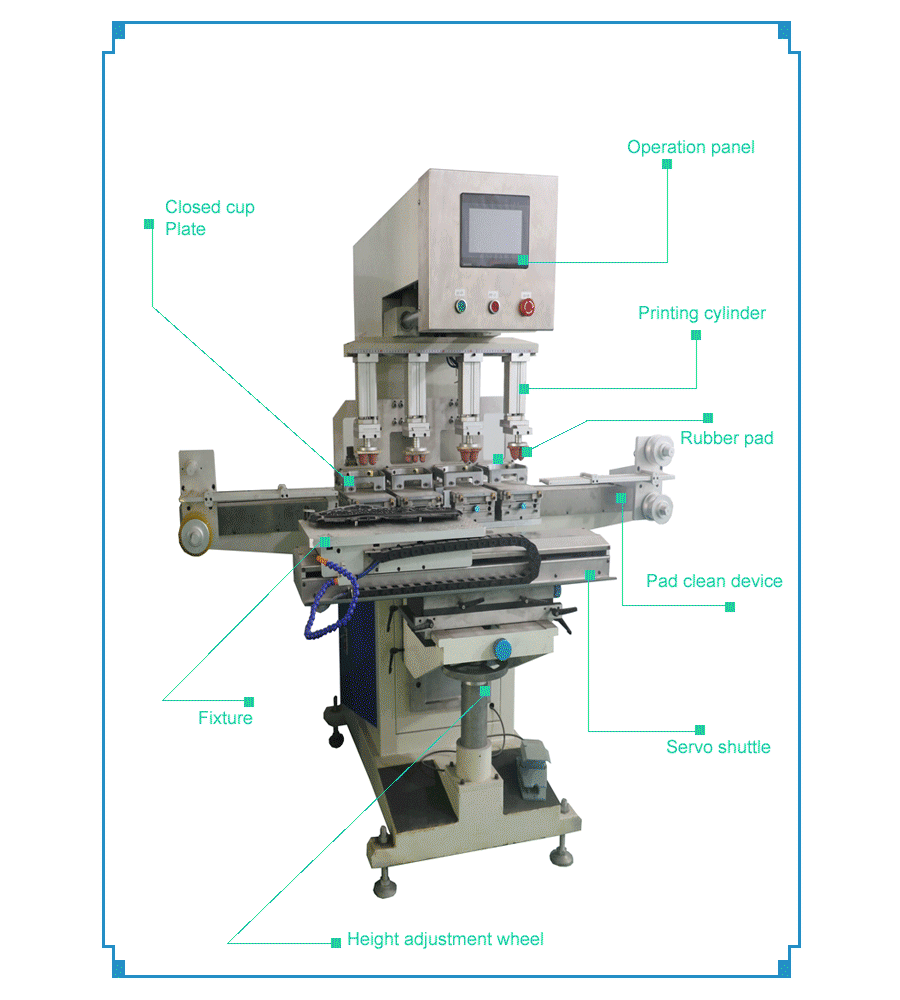Samples
The shuttle pad printer is one of the most important types of pad printers. It is equipped with a mobile workbench that can shuttle and change in different printing positions, which can achieve accurate color registration. The earliest shuttle workbench was controlled by a cylinder, with low positioning accuracy and limited printing functions. It is generally only suitable for multi-color pad printing at the same position of the same product, and its production efficiency is severely restricted. With the increase in labor costs and the continuous improvement of pad printing machine functions, the shuttle workbench is upgraded, and the servo motor control is used to greatly improve the position accuracy of the shuttle workbench. At the same time, the shuttle workbench can also be installed with a servo device that can adjust horizontally, vertically, and angles in multiple dimensions to achieve one-time complex pad printing of products in multiple directions, angles, and colors. This type of pad printer usually analyzes the pad printing position and characteristics of the product, and finely sets various parameters and controls them under computer control, so as to achieve the purpose of fully pad printing a product with one machine, greatly improving production efficiency, which is equivalent to the automatic combination of multiple single-color pad printers.
Servo shuttle pad printers have been widely used in the printing fields of household appliances, electronics, auto parts, telecommunication products, toys, hardware paper products, plastic products, gifts, crafts and stationery products.

Closed cup pad printer with servo shuttle working table//Usage and characters
- Configure shuttle table, servo motor drive, high precision, can be up and down, back and forth, left and right to adjust the angle of rotation.
- Shuttle stroke 200m, for the dimensions of 250 × 300mm printing products, the relative position between the respective printing colors can be flexibly adjusted.
- Ink cup for ink, ink saving more ink suitable stability, better environmental protection; 86% reduction in solvent evaporation, ink save 25% more business through the ISO14001 environmental management system certification;
- Automatic pad cleaning device in the pad printing process, plastic head surface residual ink can be self-cleaning, to avoid the influence of the first printing. Effectively improve the print quality;
- Independent oil cup propelling mechanism, wiper cleaner, safety design, ensure the operation more humane, scraping scraping under pressure to ensure a clean minimal, maximize oil cup and plate life;
- Thin and thick sheets double structure design, the user can choose according to their needs.
- Plastic cylinder head and the platen is controlled by a separate printing color between the mutual non-interference; can achieve multicolor printing large objects, tune more convenient.
|
4 colors servo closed cup pad printer with shuttle//Parameter
|
- Max. plate size: 100×250mm.
- Max. worktable area: 165×200mm.
- Sealed cup diameter: Φ90mm
- Max. printing speed: 850pcs/h.
- Printable color: 4
- Shuttle stroke:125mm.
- Max print area: 80×170mm.
|
- Works supply: 110V-220V Power supply;5-7Bar Compress air;
- Package dimension: 1.260×0.810×1.520m
- Gross weight: 235KG.
- CBM: 1.63246
- H.S.Code :8443198000
- Certicate: CE
|
Structure of closed cup pad printer with servo shuttle table
The 4 colors servo pad printer with shuttle table is a cutting-edge printing machine designed for high-accuracy, multi-color pad printing applications. This advanced pad printer features a mobile workbench that can shuttle and switch between different printing positions, ensuring precise color registration and seamless multi-color printing. Unlike the early models that relied on cylinder-based control systems with limited positioning accuracy, this modern version utilizes a servo motor-driven system, significantly enhancing the precision and flexibility of the printing process. The improved design allows for horizontal, vertical, and angular adjustments, enabling complex printing tasks across multiple directions and angles in a single operation. This level of versatility makes it ideal for a wide range of industries, from electronics to household appliances, where consistent and high-quality printing is essential.
The design of this pad printer includes several user-friendly elements. The independent ink cup propelling mechanism and wiper cleaner ensure a clean and stable printing environment, while the thin and thick sheets double structure allows users to choose the most appropriate configuration based on their specific needs. The separate control of the plastic cylinder head and the platen ensures that each printing color operates independently without interference, resulting in more accurate and consistent prints. Furthermore, the inclusion of an ISO14001-certified ink system reduces solvent evaporation by 86% and saves up to 25% more ink, making it an environmentally friendly option for businesses looking to minimize waste and improve sustainability.
This 4 colors servo pad printer is widely used in various industries, including electronics, automotive parts, toys, hardware, plastics, and stationery products. Its adaptability to different materials and surface types makes it a valuable asset for manufacturers who require reliable and high-quality printing solutions. Whether printing on curved surfaces, flat panels, or irregularly shaped objects, this machine delivers exceptional results with minimal effort. The combination of precision, efficiency, and environmental benefits makes it a top choice for businesses seeking to optimize their production processes.
When selecting components for this 4 colors servo pad printer, users must consider several key elements. Pad printing plates, typically made of steel or resin, are etched with the desired pattern and serve as the base for the printing process. Fixtures are essential for securing the product on the workbench, ensuring accurate alignment during printing. Ink selection depends on the material being printed, with different types available to match specific substrates and color requirements. The pad printing rubber head must be chosen based on the shape and complexity of the design, as it plays a crucial role in transferring the ink to the product surface. Finally, the blade or oil cup, depending on the type of machine, is responsible for scraping excess ink from the plate, ensuring clean and sharp prints.

Pad printers target a wide variety of products, with differences in shape and material. Different products have different printing positions and printing effects. Printing engineers must design different printing processes and select different printing consumables according to user needs.
1) Pad printing plates: The plates are made of thick steel plates, thin steel sheets, resin plates, etc. They are used on oil cup pad printers or open pad printers. The printed pattern needs to be etched on the plates. Generally, a single-color pad printer is equipped with one plate, a two-color pad printer is equipped with two plates, and so on.
2) Fixture: The printed product must be fixed on the workbench with a fixture to ensure that the printing position meets the requirements. The fixture can be made of metal or non-metal materials. A single-color pad printer and a shuttle pad printer require a fixture, while a turntable pad printer needs to be equipped with a number of fixtures equal to the number of workstations.
3) Ink: The ink type is selected according to the material of the product, and the ink color is selected according to the printed pattern. Different types of inks should match different pad printing processes. After the ink dries, it should be able to firmly adhere to the product surface. A single-color pad printer uses one color of ink at a time, a four-color pad printer uses four colors of ink, and so on.
4) Pad printing rubber head: Different product shapes and different pad printing patterns require pad printing rubber heads of different shapes. The pad printing rubber head should be able to perfectly achieve the pad printing task and maintain the stability of the properties.
5) Blade or ink cup: Blades are used on open pad printing machines, and oil cups are used on closed pad printing machines. Blades and oil cups should be able to scrape off the ink on the steel plate and should be replaced in time when damaged.
Development trend of pad printers:
Intelligent and automated pad printers: With the advancement of Industry 4.0, pad printers are developing towards automation and intelligence. For example, unmanned operation can be achieved through robot loading and unloading and AI visual inspection systems.
- Environmentally friendly pad printers: Environmental regulations are becoming stricter, the pad printing industry needs to reduce VOC emissions, the market size of environmentally friendly inks is expanding, and pad printers using UV LED curing technology and solvent-free inks will become mainstream.
- High-precision and multifunctional pad printers: In the future, the positioning accuracy of pad printers will be further improved, from the current ±0.05mm to ±0.01mm, and multiple processes will be integrated, such as pad printing combined with inkjet printing and laser etching.
- Modular and personalized pad printers: In order to adapt to the diverse market needs, modular design will be more common, and customers can freely select functional modules, such as multi-color printing, automatic drying, etc., to reduce the cost of equipment upgrades.
How to solve the ink leakage problem of the closed cup pad printer?
The closed cup pad printer seals the ink in the ink cup to ensure the stability of the ink suitability, reduce the consumption of ink, control the volatilization of solvents, and clean the operating environment. However, the leakage of ink from the joint between the ink cup and the steel plate is also a major problem. The operator should adjust it from the following aspects:
1. Ink cup and steel plate
Check and clean the ink residue, foreign matter or scratches on the surface of the steel plate. If the wear is serious, a new steel plate needs to be replaced; use a whetstone to lightly polish the burrs on the edge of the oil cup to ensure that the edge is flat. Appropriately increase the fitting pressure between the oil cup and the steel plate so that it does not hinder the sliding of the oil cup and there is no ink leakage, and avoid too loose pressure to cause gaps.
2. Ink adjustment
Control the viscosity of the ink: If the ink is too thin, it is easy to seep out from the gap. A special thickener can be added in proportion; if it is too thick, it will aggravate the wear of the parts, and a special diluent needs to be used to adjust it to the appropriate viscosity. Thoroughly clean the residual ink in the ink cup to prevent the dried ink from clogging the sealing surface or wearing parts.
3. Ink cup push mechanism
When the ink cup slides, it leaks due to misalignment. Check whether the guide rail is loose or deformed, and tighten or replace it in time; ensure that the sliding track of the ink cup is parallel to the steel plate to avoid tilting friction, and regularly add lubricating oil to the sliding parts to reduce wear and ensure smooth movement.












